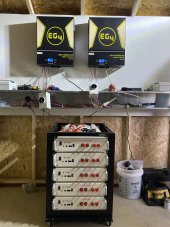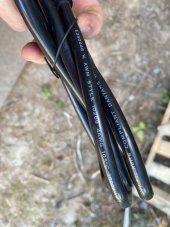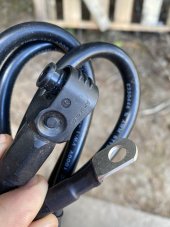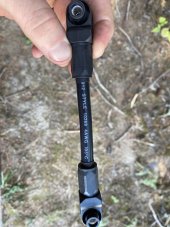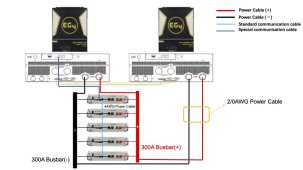PNW_Solar_Guy
New Member
- Joined
- Mar 31, 2022
- Messages
- 25
Seeking advice from anyone with experience wiring battery banks to two EG5 6500EX inverters. I am admittedly new to solar installations so I'd love it if anyone wants to 'dumb it down' and lay out the basics of why a certain wiring configuration should be used for our setup.
Equipment list:
The batteries came with 2 pairs of 6ft 4AWG cables that I had planned to use to connect the bank to the inverters, but I believe these cables are undersized for this purpose. And if I do purchase new cables to run from the battery bank to the inverters, does anyone know where to purchase the quick connect fittings I would need to attach that new larger cable to the Pytes battery quick connect battery lugs?
Here are two photos. The one with the wiring is the image I was shown before we bought the 5 Pytes batteries. The other image is a picture of our actual setup as it stands right now. Note: PV wiring and disconnects were just wired in to test the inverters and will all be properly placed in the wireway and conduit now that it has been tested.
Equipment list:
- (5) 5.12kWh Pytes E-BOX-48100R server rack batteries
- (5) pairs of 6" battery to battery 4AWG cables (one red, one black)
- (2) pairs of 72" 4AWG cables (one side is quick connect, other side is lug crimped)
- Communication cables to connect to each battery, and earthing cables for grounding
- I also purchased two 6500EX inverters and have them connected for split phase output (so we have 240v to power our well pump, and other bigger loads when needed)
The batteries came with 2 pairs of 6ft 4AWG cables that I had planned to use to connect the bank to the inverters, but I believe these cables are undersized for this purpose. And if I do purchase new cables to run from the battery bank to the inverters, does anyone know where to purchase the quick connect fittings I would need to attach that new larger cable to the Pytes battery quick connect battery lugs?
Here are two photos. The one with the wiring is the image I was shown before we bought the 5 Pytes batteries. The other image is a picture of our actual setup as it stands right now. Note: PV wiring and disconnects were just wired in to test the inverters and will all be properly placed in the wireway and conduit now that it has been tested.




